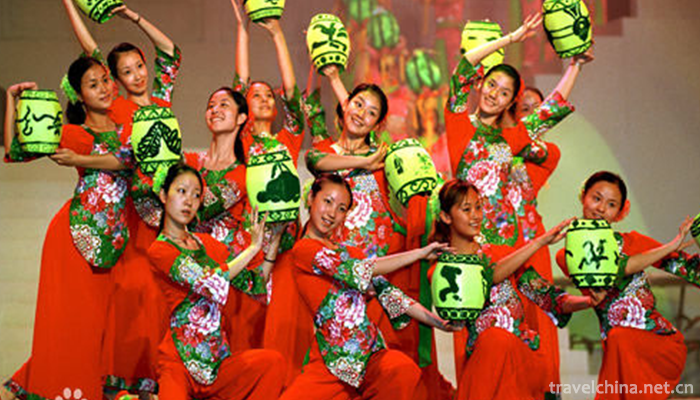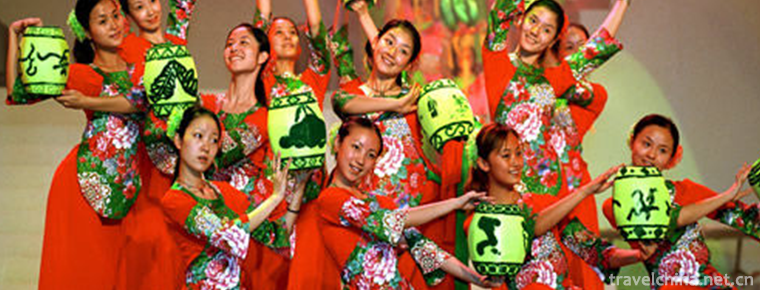Lantern Dance
Lantern Dance
Lantern dance is a Chinese folk dance with a long history. It has been performed mainly on Lantern Festival for at least 1,000 years. Lantern dance originated from Lantern Festival and its production technology has developed to a certain level. The dance form of lanterns as props has various names because of the different shapes of lanterns. Its performance is well known in the south. Lantern dance has been popular in Ming and Qing dynasties. It is mainly recorded in the literature of Qing dynasty. In night performances, colored lights illuminate the lights and people are interesting, or form different formations and patterns through colored lights, or put the words "auspicious" and "peace in the world", or express various artistic conceptions in changes and interspersions.
In June 2008, the lantern dances jointly declared by Putian, Fujian, Ji'an, Jiangxi, Shenzhen, Anhui, Dongzhi and Boai County of Henan Province (Qingtian Fish Lantern Dance, Putian Kowloon Carp Lantern Dance, Carp Lantern Dance, Shatoujiao Fish Lantern Dance, Dongzhi Flower Lantern Dance and Sujia Dragon and Phoenix Lantern Dance) were listed in the second batch of national intangible cultural heritage list with the approval of the State Council.
historical origin
In the performance, the lights are invisible, the patterns are moving and static, and the changes of different levels are mysterious, mysterious and fascinating. The dancing lamps are mostly group dancing, and the shapes of the lamps are animals, flowers and symbols of auspiciousness. In the performance, dancers can dance with one lamp or even more people, which can be divided into many forms, such as holding, lifting and dancing with lamps. Dragon lanterns and carp lanterns are lantern dances. The dragon lantern, also known as the fire dragon, can burn candles in each section and one person raises pearls to make fun of it. Its performances include "playing pearls", "piercing waves", "golden dragon and jade pillar" and so on. During the process, the masses lit more fireworks and firecrackers to boost their spirits, and the atmosphere was warm.
By the Qing Dynasty, lantern dancing had developed to a higher level, and had certain performance programs and titles. Records in the Eaves Exposed Miscellaneous Records show that during the Qianlong Lantern Festival, there were 3000 lantern dancers in Xichang, Beijing. The dancers sang "Taiping Song" and danced in a circle, changing their formations, forming the characters of Taiping, Ping, Wanwan and Niao in turn. Today's Music Textual Research records that when the emperor visited the Lantern festival, there were 3000 people. There are thirty-six sets of performance routines for Shideng Dance, such as Taiji Mixed Yuan, Sixiangsheng Bafeng, Jinka characters and so on. Those with auspicious meanings are: heavy joy, five colors of auspicious clouds, money everywhere, etc. The poems are named as: walking Jinlian, Peacock Flying south, fire dragon playing sea and so on. Those related to the ancient battlefield are: Mandarin Ducks, Shaoqi Camp, etc. This dance is performed by twelve people, each holding two flower lanterns, side. Dancing while singing "Happy Moving Mandarin Duck" and "Joy on Earth". Such a wonderful performance is naturally the ingenuity of a learned expert.
Confucius Shangren, the author of Peach Blossom Fan, also has a description of Lantern dancing. In his poem Dancing Lantern, he describes 12 women's wonderful and moving performances. In the poem, there are such famous sentences as "Twelve Golden Barium 24 lamps", "One thousand turns difficult to remember", "Not an old courtyard score, every dance is easy", "Seeing Qincheng changing into Han Palace, instantly disintegrating into a flat ground". Finally, Zhang Xu is quoted. Looking at the allusions of Gong Sun Da-niang's development in cursive script after her sword-dancing, we admire that the artistic effect of lantern dancing surpasses that of sword-dancing, and conclude the poem with "Calligraphy Enlightenment in Gong Sun-nian, let alone Dancing Lantern Wins Sword Dancing". The level of lantern dancing performed by 12 women is beyond doubt. The lantern dancing played a role of propaganda revolution during the Anti-Japanese War. After the founding of the People's Republic of China, lotus lanterns originating from the people came onto the stage and were adapted into Lotus Dance, which has a very high artistic sublimation in props, costumes and performing artistic conception. It expresses the Chinese people's love for peace and has become a well-known excellent dance program at home and abroad. In 953, the World Youth Festival won a silver medal.
artistic characteristics
In the "lantern dance", especially the "cow's lamp" has local characteristics. The "cow's lamp" uses bamboo knitted cow's head, black linen cloth as its body and hemp rope dyed black as its tail. The cow's head and cow's head are worn by two people. The cowboy dances together, causing difficult movements, such as drilling fire rings, climbing benches and turning over platforms, to show joy and auspiciousness.
Watermelon lantern dance is a new program in the 1980s. Liu Lankai, the "King of Watermelon", is a famous, big and sweet watermelon. People make "Watermelon" lanterns to celebrate the policy of reform and opening up.
Inheritance status
Chinese traditional folk dances have been performed mainly on the Lantern Festival for at least 1,000 years. The lanterns in different forms can be divided into three categories: 1) simulating animal images, such as dragon lanterns, fish lanterns, crane lanterns, Phoenix lanterns, Kirin lanterns, hundred bird lanterns, etc.; 2) simulating flowers, such as lotus lanterns, butterfly lanterns, etc.; 3) other shapes, such as boat lanterns, car lanterns, umbrella lanterns, cloud lanterns, etc. Lift the lamp in your hand, such as a fish lamp; some carry it on your shoulders, such as a tea basket lamp; some hang it on your waist, such as a boat lamp; some hang it on your legs, such as a lotus lamp; some display patterns on the ground, such as the Yellow River nine-track lamp; some dance one lamp, one person dance two lights, and more people dance one lamp, such as dragon lantern. The lantern dance is mostly group dance, night performance, colorful lantern, warm atmosphere, and then accompanied by it. Gongs and drums, fireworks and firecrackers are lively and spectacular.
Lantern dancing includes lamps, dances, boat lanterns, cow lanterns, dragon lanterns, lion lanterns, high-feet lanterns, low-feet lanterns, watermelon lanterns, dancing with body singing and dancing, lotus flute dance, butterfly dance, clam shell dance and stage performance dance.


-
1.Jiayuguan cultural relics scenic spot
Jiayuguan: World Cultural Heritage, National AAAAA Tourist Scenic Spot, National Key Cultural Relics Protection Unit, National Patriotic Education Demonstration Base.
Time 2018-12-12 -
2.Jinsi Gorge Scenic Area
Jinsi Gorge Scenic Area of Shangluo City, Shaanxi Province, is located in the hinterland of Xinkailing in the southeast of Shangnan County, Shangluo City.
Time 2018-12-12 -
3.Sanxingdui Museum
The Sanxingdui Museum was founded in August 1992 and opened in October 1997. It is located in the northeast corner of Sanxingdui Site, a national key cultural relic protection unit.
Time 2018-12-18 -
4.Wu Songgun Taiwan Wetland Forest Park
Wu Song Gu Taiwan Wetland Forest Park: Wu Song Gu Taiwan Wetland Forest Park with a total area of 53.46 hectares is located in the eastern part of Baoshan District
Time 2019-02-22 -
5.Changde silk string
Changde Silk String is a traditional local music popular in the Yuanjiang and Lishui areas of Changde, Hunan Province. At the end of Ming Dynasty and the beginning of Qing Dynasty
Time 2019-04-16 -
6.Traditional fine arts
China's traditional art heritage is extremely rich and brilliant. Traditional art painting, calligraphy, music, dance, opera, gardens, architecture, sculpture, arts and crafts, traditional cuisine and
Time 2019-04-19 -
7.Gino Encouragement
Great encouragement, traditional dance in Jinghong City, Yunnan Province, is one of the national intangible cultural heritage.
Time 2019-05-05 -
8.Construction Techniques of Stone Bridge
Shaoxing's ancient bridge construction techniques can be traced back to the Spring and Autumn Period and the Warring States Period. To the Han Dynasty, the stone arch bridge construction techniques be
Time 2019-06-15 -
9.Beijing Second College of Foreign Languages
Beijing Second Foreign Language College is a famous university with advantages of foreign language and literature and tourism management, and coordinated development of literature, management, economi
Time 2019-09-06 -
10.Beijing Police College
Beijing Police College is a full-time general undergraduate college approved by the Ministry of Education, sponsored by the Beijing Municipal People's Government, administered by the Beijing Public Se
Time 2019-09-06 -
11.Suining science and technology
In 2019, Suining achieved a high-tech industry revenue of 50.2 billion yuan, an increase of 22.4%, and social R & D investment reached 860 million yuan, a year-on-year increase of 37.3%, and the investment intensity reached 0.7%. In the whole year,
Time 2020-12-16 -
12.Nanchong Education
By the end of 2019, there were 271 primary schools in Nanchong, with 57000 students enrolled and 356700 students in school. The enrollment rate of primary school-age children was 100%. There are 427 junior high schools with 62900 students and 185300 students in school.
Time 2020-12-17